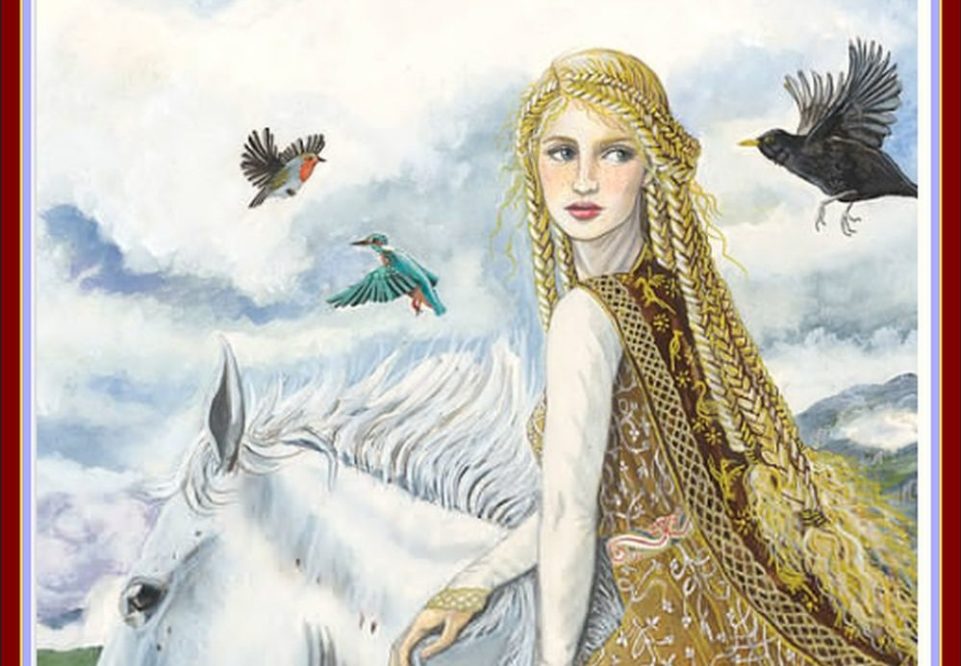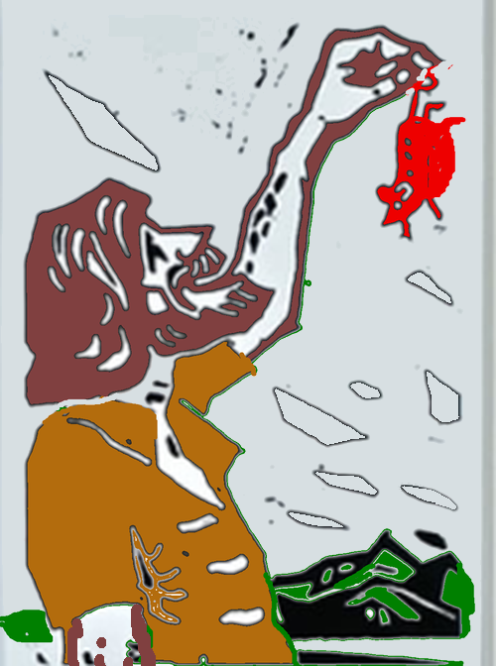Magnificent Mabinogi 9: The Women

Shân Morgain
The Women’s Liberation Movement exploded worldwide 1970s at the same time as Mabinogi Studies was upended by its own huge change.
The old, sad view, ‘broken remains’ of a ‘Celtic pantheon’ mythology was transcended by a vivid, vigorous literature, unified, intricate.
John Bollard, 1970s-90s architect of the new paradigm (dominant point of view) observed uneasily ‘the role of women in the Four Branches of the Mabinogi has so far not been adequately defined or examined, though no one would deny that women play a significant part in the tales’.

Unknown to Bollard right as he said that, the eminent Welsh poet and feminist Andreas Pennar was researching ‘Women in Medieval Welsh Literature’ (D.Phil. Oxford 1975). But Pennar remained obscure, so the crown of pioneering feminist research went to ‘Rob’ Valente (1986). Her insights moved beyond Pennar’s general survey.
Valente pointed out that constant emphasis on goddesses* blocked our view of women’s humanity. For example, Rhiannon’s failed attempt to rescue her captive son (PKM3) was considered her failure as a Goddess, rash, impulsive (Mac Cana 1977).
But Valente insists Rhiannon’s action is perfectly natural as a mother: we would see her as ‘a heartless creature’ if she did not try to aid her son (1986). Valente also felt Mabinogi women exercised their substantial power through the voice.
Women characters

Understanding of Mabinogi women went from strength to strength. I have investigated how ‘Rhiannon’s Choice’ to marry Pwyll of Dyfed reverberates through the four Branches.
Pwyll’s adventure in Annwfn, which starts the Mabinogi, seems puzzling, apparently independent/ disconnected from the long drama which follows. Some suggest it ‘equips’ Pwyll as a hero: a masculine agenda.
I propose Pwyll’s fame as Pen Annwfn is precisely what prompts Rhiannon to choose him above the perfectly appropriate, princely Gwawl, with consequent reverberations. A feminine agenda.
Last week I noted how marriages and friendships for Mabinogi characters are hybrid, affection mixed with political/ economic advantage. Rhiannon is a stateswoman, urgently concerned to conserve her wealth. Recruiting Pwyll’s might means she escapes paying huge sarhaed (compensation) to princely Gwawl.
Both Rhiannon and Branwen have been framed as the Calumniated Wife: a story theme about the outsider wife suffering hostility from her married family. Branwen certainly fits, a clear case of how vulnerable a woman can be in a patrilocal system where a wife lives with her husband’s family, away from her own circle.
Rhiannon, not so much. Pwyll is the reverse of hostile to her, standing loyal when a nobles’ faction attacks her as firstly barren, later a baby killer. He firmly mediates his Council to accept compromise about her.
I suggest these noble hostilities are led by Pendaran. Consider his tension with Rhiannon when they tussle the naming of the restored boy. Rhiannon’s disloyal Maids show remarkably instant plotting readiness and staunch unity. Pendaran is a good candidate to organise them.
‘Rieni’

Branwen is the highest status, royal female of Britain. Her suitor, the King of Ireland, admires her as one of three prif rieni/ chief ancestresses? It’s distinctively Welsh, but cryptic in meaning.
The problem is that Branwen’s son is brutally murdered, then she herself dies. She cannot be ancestress of a royal lineage. More, when acclaimed rieni Branwen is a virgin.
There are three of these chief rieni the other two unnamed. Ifor Williams proposed Branwen, Rhiannon, Arianrhod. But the sons of Rhiannon and Arianrhod are not recorded as fathers (Pryderi might be, if so that is lost to us). So how can these women be ancestresses as their title suggests?
Will Parker offers a neat solution. In noble kindred a key female holds the potential of bearing the heir. Thus a rieni female can even be a babe in arms, and easily unmarried. I add, presumably not post-menopausal.
Male bias

I come across many examples where masculinity blocks or distorts the feminine view. ‘Rhiannon’s Choice’ of Pwyll Pen Annwfn is one. Ford says Pwyll ‘wins’ Rhiannon, when clearly she chooses to come and get him, to use him for her own neges/ purpose.
Arianrhod is often said to be vanquished by Gwydion in their power struggle. Yet he only gets his way by tricking her to follow her own directives (Lleu’s name and arms). On her third mandate to ban Lleu any human wife, Arianrhod is unconquered.
The appalling abuse when two males force young girl Arianrhod to give birth in public receives no attention.
‘Lady Mouse’ is caught captive because (female) she is heavily pregnant. If she is given any attention it’s as a hilarious joke. The deep vulnerability of late pregnancy, the terror of this captive female awaiting death, is nowhere remarked.
Manawydan is applauded for merely not raping or abusing Pryderi’s young wife when alone with her. Cigfa’s role as adviser is sometimes noted, but the fawning on Manawydan ignores that he totally ignores her counsel.
Blodeuedd is a male wet dream, a beautiful sex doll constructed for male sexual needs. Her attempt at independence is predictably, merely a transfer to a new sex master. She is hailed Lady of Flowers but they are actual, poisonous flowers, warning of the backlash held in female slavery.
Female authors & scholars

Andrew Breeze offered us a famous theory: the composer of the Mabinogi might be a noble woman. This is possible for the tales have much womanly stuff about marriages, children, and organising feasts. Some characters are undeniably strong and impressive women.
Breeze pins authorship to the famous Gwenllian, which is less secure. Her family position and marriage make her a candidate but there are many others like her.
The giantess, the powerhouse, of female scholars in Mabinogi Studies, is of course Charlotte Guest. To me she bestrides transition from the Welsh to English focus. Her faithfulness to her Welsh mentors (Carnhuanawc, Tegid) makes it unlikely she intended to Englishify, but in effect she did.
Guest is otherwise problematic. Her wealth equipped her to be chosen by her mentors to publish the Mabinogion, but this English aristocrat was enriched by exploited Welsh labour. Her workers in iron and steel were not consulted on her decision to use their money for lavish books.
Female scholars were few until the mid-20thC, as women were barred or not supported to access higher education.
Elizabeth Lloyd (MA 1911) was a protégée of Edward Anwyl, himself obscured by the dreamer WJG. Sadly Anwyl died relatively young at barely 48, Rhŷs died the next year, and Lloyd at 25 lacked the seniority to stand up to WJG’s depredations.
Eleanor Hull traced Annwfn (1907) from native ‘Otherworld’ (positive), to Classical ‘Hades’ (neutral), to Christianised ‘Hell’ (negative).
Rachel Bromwich compiled a treasurehouse of the Welsh Trioedd/ Triads with copious notes on Mabinogi characters (TYP 1966). The Trioedd are short memory aids, part of the poets’ tradition. Characters linked to Rhiannon do not appear much because they belong to the new prose tradition.
Sioned Davies (1982ff.) followed her mentor Brynley Roberts on the Mabinogi as originally oral tradition, performances for ‘‘a hearing public’ (1998).
Voice-to-ear shaped how the tales were told, rich in dialogue, repetition for emphasis (no Bold or large font), aiding audience memory (no clicking or flipping back to check). Davies’ defended Guest against her accusers, not least supposed plagiarism (2004).
Pennar and Valente pioneered feminist analysis (1975, 1986) above. More came from Evangeline Walton (1970s), Elizabeth Hanson-Smith (1981/82). Revel Guest & Angela V. John (1989/ 2007), Miranda Green (189ff), Fiona Winward (1997), Rhiannon Mary Davies (1993) Erica J. Sessle (1994), Jessica (Hooker) Hemming (1995), Donna Rae White (1995, 1996), Catherine McKenna (1996). Kathy E. Shimpock (2017), Emma Watkins (2018) – and me slaving away since 2012.
The first online Mabinogi text (Guest’s version) appeared on an Arthurian site by ‘Miss Gien’ (1999).

…………………………………………………………………………………………………..
Header image: Rebecca Jane Stockburn (Jan. 2016) ‘Rhiannon’, gold embellished painting. It hangs above my bed, generously gifted to me by Dr. Roy Davies of Narberth.
* Goddesses. Patience my friends I shall reach this favourite topic next week.
**John Cleal (Workshop Wales, Fishguard, 1989), painted leather tabletop, gold highlights. Inspired by Williams (1843). Cleal omits Pwyll following behind. Commissioned by Angela John to celebrate publication of Lady Charlotte: A Biography of the Nineteenth Century; 2nd abbreviated edn. Extraordinary Life (2007). Photos by John Davies (April 2017).
** Miss Gien’s website is no more with us but may be accessed via Internet Archive, Wayback Machine. Jansen, ‘Miss Gien’. 1999. ‘The Mabinogion: The Welsh Mythology’ (Netherlands).
Scholars referenced in this series can be found in my Mabinogi Bibliography; dates given above should be adequate to identify specifics. Questions or comments are always welcome; contact me via LinkedIn or Academia.edu
‘The Magnificent Mabinogi’ title was first used by the playwright director Manon Eames for her famous staging, Aberystwyth Arts 2008; used here with her permission.
‘Magnificent Mabinogi’ series. 1) Genius 2) Stories 3) Howlers 4) Canon & Construction 5) Places of power 6) Myth/ Literature? 7) Politics 8) Everyday life CURRENT 9) Women NEXT 10) Goddesses and Gods
Support our Nation today
For the price of a cup of coffee a month you can help us create an independent, not-for-profit, national news service for the people of Wales, by the people of Wales.





Oops blush I left out Miranda (Aldhouse) Green, fine work 1989, 1990s, 21stC. She’ll appear next week regarding Goddesses & Gods but that’s no excuse. Mea culpa.